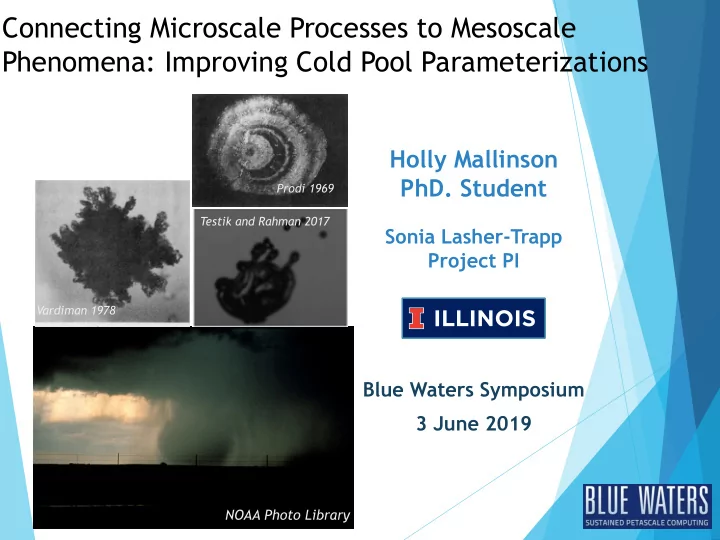

Connecting Microscale Processes to Mesoscale Phenomena: Improving Cold Pool Parameterizations Holly Mallinson PhD. Student Prodi 1969 Testik and Rahman 2017 Sonia Lasher-Trapp Project PI Vardiman 1978 Blue Waters Symposium 3 June 2019 NOAA Photo Library
I use Blue Waters to... Connect small-scale (precipitation) processes to larger- scale (thunderstorm) phenomena What kind(s) of precipitation are most important for forming, u sustaining, and determining cold pool properties u A stronger storm outflow can generate new storm development however… u Parameterizations in larger-scale models lack sufficient representation of convective components (i.e. cold pools) u Thus larger-scale models fail to predict longer episodes of convective activity! Improving parameterizations requires a detailed understanding u of the physical drivers of cold pools u Requires multiple realizations of high-resolution simulations, with high-frequency output of large data files to quantify has allowed us to pursue these questions!
Cold Pool Overview km km Downdraft (outflow) 75 75 Updraft (inflow) 50 50 25 25 km km 25 75 100 50 75 100 25 50 Cold Pool Mallinson and Lasher-Trapp, in review
Precipitation Processes Recall: Improving parameterizations requires a detailed u understanding of the physical drivers of cold pools To accomplish this, we want to u change the precipitating hydrometeor’s properties Variability in the initial fields u creates variability in the precipitation properties (i.e. “trickle-down” effect) This changes microphysical u characteristics of storms while keeping dynamics relatively unchanged! &HAIL
To summarize… We change the initial precipitation processes to look at how hydrometeors influence cold pools Mallinson and Lasher-Trapp, in review Requires multiple realizations of high-resolution simulations, with high-frequency output of large data files to quantify
Model and Analysis Tools CM1 Model– Dr. George Bryan, NCAR u u Coarse-grained, pure MPI, 3D cloud model, designed to scale to tens of thousands of processors, written in FORTRAN u 3 rd -order RK integration; 5 th /6 th order advection u NSSL double-moment microphysics (important for precip. development, but increases number of calculations and memory required) u Domain sizes are 250 kilometers wide; grid spacing is 250 m with a time step of 1 second u 80 million grid boxes in domain u 800 node hours per run This is the most number of simulations and the highest resolution that has been used to address this topic
Cold Pool Formation Still ambiguity regarding most u important downdraft properties forming cold pool Variability in dominant u hydrometeor Range of downdraft strengths u that form the cold pool However…speed of rain u formation (warm-rain process) appear most important for determining cold pool onset Mallinson and Lasher-Trapp, in review
Cold Pool Sustenance ▶ Calculations of latent cooling in downdrafts (offline): ▶ NCL/FORTRAN code searches for cold pool & associated downdrafts connected to it at each output time ✓ ✓ ✓ ✓ ✓ ✓ ✓ ✓ ✓ ✓ ✓ ✓ ✓ ✓ ✓ ✓ ✓ ✓ ✓ Cold Pool Theta Perturbation and Strong Downdrafts Theta Perturbation
Cold Pool Sustenance ▶ Calculations of latent cooling in downdrafts (offline): ▶ NCL/FORTRAN code searches for cold pool & associated downdrafts connected to it at each output time ✓ ✓ ✓ ✓ ✓ ✓ ✓ ✓ ✓ ✓ ✓ ✓ ✓ ✓ ✓ ✓ ✓ ✓ ✓ Mallinson and Lasher- Trapp, in Cold Pool review
Cold Pool Sustainment Graupel is the dominate u hydrometeor in all realizations despite differences in the initial microphysics But rain evaporation has u the strongest influence on: u Expansion rate u Depth u Strength Mallinson and Lasher-Trapp, in review
Cold Pool Sustainment But rain evaporation has u the strongest influence on: u Expansion rate u Depth u Strength Theorized this is because u rain evaporation is occurring within the cold pool Mallinson and Lasher-Trapp, in review
Cold Pool Sustainment Theorized this is because rain evaporation is u occurring within the cold pool Limiting latent cooling calculations to lower u heights supports this This has also helped reconcile differences u seen in past studies u Capping latent cooling calculations at 4 km vs. entire domain depth Mallinson and Lasher-Trapp, in review
Summary I use Blue Waters to: Connect small-scale (precipitation) processes to larger-scale (thunderstorm) phenomena u We achieve this by changing the initial precipitation processes to look at how hydrometeors influence cold pools u Rain processes determine cold pool formation u Graupel is the dominant hydrometeor sustaining the cold pool u Rain evaporation has the strongest influence on cold pool properties
Implications for Larger-Scale Weather and Climate Models u Consideration of the microphysics in deep convection is necessary to accurately represent cold pools and their effects in parameterizations u Cold pool onset could be parameterized using local CCN values and cloud-base temperatures u Large amounts of near-surface rainfall can help parameterize cold pool properties u Cold pool sustainment is governed by graupel u Related to amount of IN (not well quantified) u Most schemes only allow for graupel OR hail
Challenges & Solutions u NCL routines running out of memory u Run in subsections or with fewer variables u Faster analysis with VisIt and NCL codes u We trim the data files to remove most of the empty space around the clouds/storms, for analysis and longer-term storage u Searching large domains for continuous surfaces meeting certain criteria u Cumbersome FORTRAN & NCL routines used u Development of MATLAB routine with help from Blue Waters team to address memory issues ▶ Storage of data files while running analysis code ▶ Trimming files works to an extent but still trying to think of a better solution
Acknowledgements u Blue Waters Project and Team, NCSA u Dr. George Bryan for use of the CM1 community model u Dr. Ted Mansell for use of the NSSL microphysics scheme u DOE (DE-SC0014101)
Recommend
More recommend